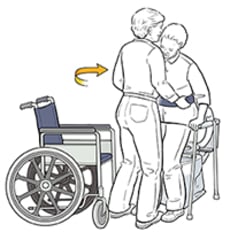If your loved one will use a wheelchair, you need to know about transfers. For safety's sake, learn how to help them in and out of the wheelchair. One basic method is shown here.
Important safety tips
Lifting a person can be hard on your back. To reduce the risk of a back injury, remember to do the following:
- Organize the steps in your head before you start.
- Explain the steps of the move and ask the person to tell you when they are ready to transfer.
- Keep the person close to you.
- Keep your knees bent and your back straight.
- Use a transfer belt to provide a firm hold, rather than clasping your hands behind the person's back.
- Get help when you need it.
- Ask to practice with supervision.



